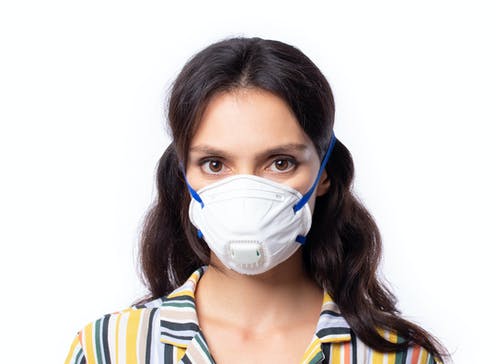During the pandemic, the prevailing thought has been that a high-filtration mask – such as an N95, KN95 or FFP3 – should offer better protection than a surgical or fabric mask. However, recent research I conducted with colleagues at the University of Cambridge suggests this isn’t necessarily the case. For these masks to be highly protective, they must properly fit the wearer, but often they don’t.
This is itself an issue, but our research also discovered another worrying thing: people aren’t very good at assessing whether their mask fits. Frequently, they use a self-assessment method to check fit, which we found to be unreliable. This suggests people may be acting as though they’re wearing a well-fitting mask when they aren’t, which increases the risk of them catching and spreading the coronavirus.
Given this, we decided to conduct a second piece of research, to see if we could improve the fit-checking method. This resulted in us creating a potential new way of testing whether a mask fits that can be performed at home with materials costing approximately £20.
Good fit isn’t universal
Our first piece of research measured how well different masks blocked ambient air particles from entering them when being worn. This involved taking continuous measurements of the concentration of air particles in the ambient air outside the mask as well as in the air inside the mask (via a valve connected to it) and then looking at differences between the two to see if air was seeping in.
This is what’s known as quantitative fit testing. It’s a commonly used and highly reliable way to test mask fit. The US Occupational Safety and Health Administration (OSHA) mandates that for an N95 or similar mask to be deemed suitable for use, it must score above 100 in such a test.
We ran quantitative fit testing with seven participants, who each tested five different types of N95 mask, as well as a KN95 mask and a surgical mask. Three participants also tested some fabric masks. This meant N95 masks were tested a total of 35 times; only in six instances did their scores exceed 100. When poorly fitting, we found the N95 masks provided not much more protection than the surgical or cloth masks. The KN95 masks also performed very poorly when they didn’t fit, offering no more protection than a cloth or surgical mask.
It therefore can’t be assumed that high-performance masks are universally highly protective. Proper fit is necessary for protection, and even the best performing mask, the 8511 N95, fit only three out of seven participants. Some N95 masks, such as the Aero Pro and Xiantao Zong, didn’t fit any of the participants adequately.
Self-assessing fit often inaccurate
Before measuring quantitative fit, we had also had the participants themselves assess whether they thought each mask fit (what’s known as qualitative fit testing). They did this by following NHS guidelines: visually and manually inspecting the mask each time, carefully feeling around the edge for air leaks and adjusting the fit as necessary. We then had participants rate each mask on two criteria – whether they believed the mask fit and how confident they were in their decision.
We then compared these self-assessments with the highly reliable, quantitative fit data that we gathered. In the following graph, you can see how the actual and estimated fit of the five N95 masks compared across the seven participants. (There were four women and three men, aged between 18 and 74. They are listed on the X axis below.)
The height of the bars shows how well the masks fit – as mentioned previously, only six times did an N95 mask fit well enough to pass the OHSA’s 100-point benchmark. The colour of the bars shows what was predicted in each self-assessment: green means the participant thought it did fit, red that it didn’t, and the darker the colour the greater the confidence in their prediction.
If predicting fit accurately, bars above the 100-point mark are green and those below are red. So, as you can see, the participants weren’t particularly accurate in assessing the fit of the various N95 masks. They correctly identified masks that did fit, but regularly misidentified poorly fitting masks as being adequately able to protect them. There’s also no correlation between their confidence in their predictions and the predictions’ accuracy.
These findings suggested that the self-administered method of checking fit used in this study isn’t reliable and that an alternative is needed.
How to improve self-assessment
We then had a go at developing a better method of qualitative fit testing that could be performed at home for a reasonable price.
In healthcare settings, a different method is used to test high-filtration masks. Rather than assess fit visually and by touch, a substance with a certain taste is released into the air around the mask wearer. If they can taste the substance, it indicates the mask doesn’t fit properly.
This technique requires a suitable enclosure, as well as a flavoured test solution and a nebuliser to spray it into the air. These supplies can be expensive and, during COVID-19, difficult to obtain. So, we showed how to replicate this method at home using inexpensive alternatives purchased on Amazon for around £20.
An aroma diffuser can replace the nebuliser, and can be used to aerolise saccharin dissolved in water into an enclosed space. The participant then tests to make sure they can taste this without a mask on, and then sees if they can taste it with a mask donned. To ensure a thorough test, the user can move the diffuser around so that its vapour touches all edges of the mask, or they could cover their head with something – such as a densely woven towel – to help concentrate the mist around their face.
It’s important to note that while this method was shown to be effective in our study, it is not regulator-approved, and so should be used at one’s own risk. We do not certify its safety.



 Canada Loses Measles-Free Status After Nearly 30 Years Amid Declining Vaccination Rates
Canada Loses Measles-Free Status After Nearly 30 Years Amid Declining Vaccination Rates  Innovent’s Xinermei Intensifies Weight-Loss Drug Battle in China
Innovent’s Xinermei Intensifies Weight-Loss Drug Battle in China  FDA Memo Raises Questions About Possible COVID-19 Vaccine Links to Rare Child Deaths
FDA Memo Raises Questions About Possible COVID-19 Vaccine Links to Rare Child Deaths  Eli Lilly’s Inluriyo Gains FDA Approval for Advanced Breast Cancer Treatment
Eli Lilly’s Inluriyo Gains FDA Approval for Advanced Breast Cancer Treatment  U.S. Experts to Reassess Newborn Hepatitis B Vaccination Guidelines Amid Growing Debate
U.S. Experts to Reassess Newborn Hepatitis B Vaccination Guidelines Amid Growing Debate  Cogent Biosciences Soars 120% on Breakthrough Phase 3 Results for Bezuclastinib in GIST Treatment
Cogent Biosciences Soars 120% on Breakthrough Phase 3 Results for Bezuclastinib in GIST Treatment  Trump and Merck KGaA Partner to Slash IVF Drug Costs and Expand Fertility Coverage
Trump and Merck KGaA Partner to Slash IVF Drug Costs and Expand Fertility Coverage  Trump Signs Executive Order to Boost AI Research in Childhood Cancer
Trump Signs Executive Order to Boost AI Research in Childhood Cancer  Eli Lilly’s Weight-Loss Pill Nears Fast-Track FDA Approval as Profits Surge on Global Demand
Eli Lilly’s Weight-Loss Pill Nears Fast-Track FDA Approval as Profits Surge on Global Demand  Merck Nears Acquisition of Cidara Therapeutics at Significant Premium
Merck Nears Acquisition of Cidara Therapeutics at Significant Premium  Pfizer Secures $10 Billion Deal for Obesity Drug Developer Metsera, Outbids Novo Nordisk
Pfizer Secures $10 Billion Deal for Obesity Drug Developer Metsera, Outbids Novo Nordisk  Novo Nordisk and Eli Lilly Lower Prices for Weight-Loss Drugs Amid U.S. Agreement
Novo Nordisk and Eli Lilly Lower Prices for Weight-Loss Drugs Amid U.S. Agreement  Bayer’s Stroke Drug Achieves Breakthrough Trial Results, Boosting Market Confidence
Bayer’s Stroke Drug Achieves Breakthrough Trial Results, Boosting Market Confidence 
































